height VOLKSWAGEN T-ROC 2022 Owners Manual
[x] Cancel search | Manufacturer: VOLKSWAGEN, Model Year: 2022, Model line: T-ROC, Model: VOLKSWAGEN T-ROC 2022Pages: 502, PDF Size: 8.58 MB
Page 17 of 502

Various, topic-specific information profiles can be selected via the Active Info Display menu option in
the vehicle settings of the Infotainment system Vehicle settings menu
information profile, the Active Info Display shows additional information in the centre of the round
instruments, or the round instruments are hidden and the additional information is displayed across
the whole width of the display. The following information profiles are available:
Gear. Digital display of the current gear or selected position.
Speed. Digital display of the speed.
Consumption. Graphic representation of current consumption and digital display of average
consumption.
Range. Digital display of the remaining range.
Dynamic Road Sign Display. Display of recognised road signs.
Distance travelled. Digital display of the distance covered.
Time of arrival information. Digital display of the remaining driving time, distance to the destination
and estimated time of arrival.
Acceleration. Graphic representation of longitudinal and lateral acceleration.
Assist systems. Graphic representation of various assist systems.
Height. Digital display of the current height above sea level.
Navigation. Graphic representation of arrow navigation.
Compass. Digital compass display.
Audio. Digital display of current audio playback.
The number and functions of the available information profiles can differ depending on the vehicle
equipment.
Navigation map in the Active Info Display
With some vehicle equipment levels, the Active Info Display is able to display a detailed map. To
display this map, select the Navigation menu item in the instrument cluster Instrument cluster
menus
The navigation map can be shown in two sizes. With the larger map size, the navigation map is
displayed over the entire width of the display. To select the preferred map size:
Press the button on the multifunction steering wheel Instrument cluster menusto switch
between map sizes as required.
Page 51 of 502
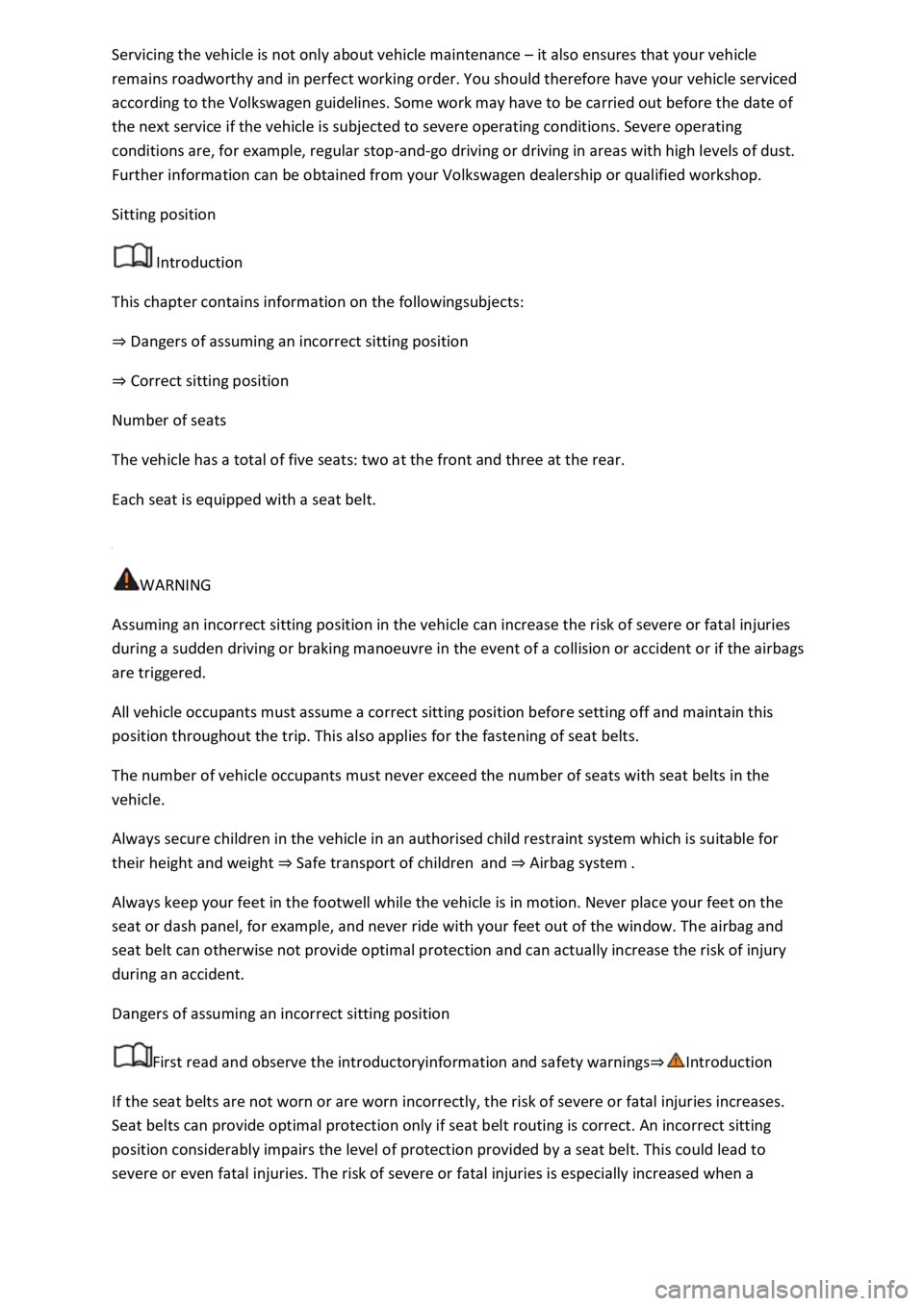
not only about vehicle maintenance it also ensures that your vehicle
remains roadworthy and in perfect working order. You should therefore have your vehicle serviced
according to the Volkswagen guidelines. Some work may have to be carried out before the date of
the next service if the vehicle is subjected to severe operating conditions. Severe operating
conditions are, for example, regular stop-and-go driving or driving in areas with high levels of dust.
Further information can be obtained from your Volkswagen dealership or qualified workshop.
Sitting position
Introduction
This chapter contains information on the followingsubjects:
Dangers of assuming an incorrect sitting position
Correct sitting posi
Number of seats
The vehicle has a total of five seats: two at the front and three at the rear.
Each seat is equipped with a seat belt.
WARNING
Assuming an incorrect sitting position in the vehicle can increase the risk of severe or fatal injuries
during a sudden driving or braking manoeuvre in the event of a collision or accident or if the airbags
are triggered.
All vehicle occupants must assume a correct sitting position before setting off and maintain this
position throughout the trip. This also applies for the fastening of seat belts.
The number of vehicle occupants must never exceed the number of seats with seat belts in the
vehicle.
Always secure children in the vehicle in an authorised child restraint system which is suitable for
their height and weight Safe transport of childrenand Airbag system
Always keep your feet in the footwell while the vehicle is in motion. Never place your feet on the
seat or dash panel, for example, and never ride with your feet out of the window. The airbag and
seat belt can otherwise not provide optimal protection and can actually increase the risk of injury
during an accident.
Dangers of assuming an incorrect sitting position
First read and observe the introductoryinformation and safety warnings
If the seat belts are not worn or are worn incorrectly, the risk of severe or fatal injuries increases.
Seat belts can provide optimal protection only if seat belt routing is correct. An incorrect sitting
position considerably impairs the level of protection provided by a seat belt. This could lead to
severe or even fatal injuries. The risk of severe or fatal injuries is especially increased when a
Page 53 of 502
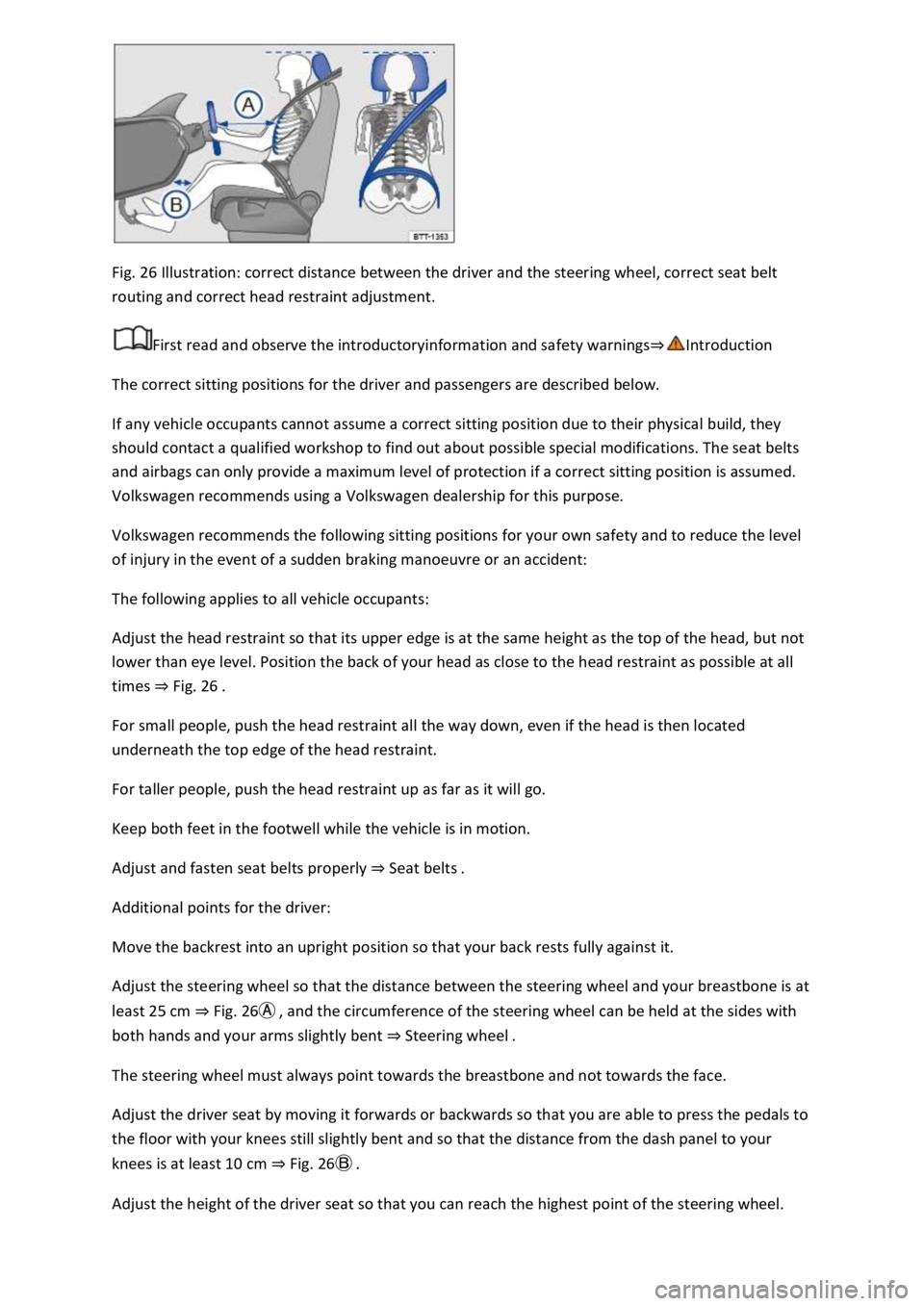
Fig. 26 Illustration: correct distance between the driver and the steering wheel, correct seat belt
routing and correct head restraint adjustment.
First read and observe the introductoryinformation and safety warnings
The correct sitting positions for the driver and passengers are described below.
If any vehicle occupants cannot assume a correct sitting position due to their physical build, they
should contact a qualified workshop to find out about possible special modifications. The seat belts
and airbags can only provide a maximum level of protection if a correct sitting position is assumed.
Volkswagen recommends using a Volkswagen dealership for this purpose.
Volkswagen recommends the following sitting positions for your own safety and to reduce the level
of injury in the event of a sudden braking manoeuvre or an accident:
The following applies to all vehicle occupants:
Adjust the head restraint so that its upper edge is at the same height as the top of the head, but not
lower than eye level. Position the back of your head as close to the head restraint as possible at all
times Fig. 26
For small people, push the head restraint all the way down, even if the head is then located
underneath the top edge of the head restraint.
For taller people, push the head restraint up as far as it will go.
Keep both feet in the footwell while the vehicle is in motion.
Adjust and fasten seat belts properly Seat belts
Additional points for the driver:
Move the backrest into an upright position so that your back rests fully against it.
Adjust the steering wheel so that the distance between the steering wheel and your breastbone is at
least 25 cm Fig. 26
both hands and your arms slightly bent Steering wheel
The steering wheel must always point towards the breastbone and not towards the face.
Adjust the driver seat by moving it forwards or backwards so that you are able to press the pedals to
the floor with your knees still slightly bent and so that the distance from the dash panel to your
knees is at least 10 cm Fig. 26
Adjust the height of the driver seat so that you can reach the highest point of the steering wheel.
Page 54 of 502

Additional points for the front passenger:
Move the backrest into an upright position so that your back rests fully against it.
Push the front passenger seat as far back as possible so that the airbag can provide maximum
protection if it is deployed.
Seat belts
Introduction
This chapter contains information on the followingsubjects:
Warning lamp
Frontal collisions and the laws of physics
What happens to vehicle occupants who have not fastened their seat belts
Seat belt protection
Using seat belts
Fastening and unfastening seat belts
Seat belt routing
Seat belt height adjuster
Belt retractor, belt tensioner, belt tension limiter
Service and disposal of belt tensioners
Proactive occupant protection system
Regularly check the condition of all seat belts. If the belt webbing, belt connections, belt retractor or
seat belt buckle become damaged, the seat belt in question should be replaced immediately by a
qualified workshop
compatible with the vehicle, equipment level and model year. Volkswagen recommends using a
Volkswagen dealership for this purpose.
WARNING
Incorrectly fastened or unfastened seat belts increase the risk of severe or fatal injuries. Seat belts
will only offer the optimum level of protection when they are fastened and used properly.
Seat belts are the most effective means of reducing the risk of serious and fatal injuries in the event
of an accident. Seat belts must always be fastened properly when the vehicle is in motion to protect
the driver and all vehicle occupants.
Page 55 of 502

seat belt belonging to their seat and keep it fastened properly throughout the trip. This applies to all
vehicle occupants and also in urban traffic.
While the vehicle is in motion, secure all children travelling in the vehicle in a restraint system
suitable for their weight and height. They must also wear correctly fastened seat belts Safe
transport of children
Drive off only when all passengers have correctly fastened their seat belts.
Never insert the latch plate into a buckle which does not belong to the corresponding seat and
always ensure it engages properly. Using a buckle which does not belong to the seat you are
occupying reduces the level of protection and can lead to severe injuries.
Never let any foreign bodies or liquids get into the slots for the belt buckles. This could prevent the
belt buckle and seat belt from working properly.
Never unfasten the seat belt while the vehicle is in motion.
Never allow more than one person to share the same seat belt.
Never travel when children or babies are being carried on somebody's lap and fastened with the
same belt.
Never travel wearing loose, bulky clothing (such as an overcoat over a jacket). This could prevent the
seat belts from fitting and functioning properly.
WARNING
Damaged seat belts are very dangerous and could cause severe or fatal injuries.
Never damage the belt by trapping it in the door or in the seat mechanism.
If the belt webbing or any other part of the seat belt becomes damaged, the seat belts may tear
during an accident or sudden braking manoeuvre.
Have damaged seat belts immediately replaced by new seat belts that have been approved by
Volkswagen for the vehicle. Seat belts subjected to stress and stretched during an accident must be
replaced by a qualified workshop. Renewal may be necessary even if there is no apparent damage.
The belt anchorage should also be checked.
Never try to repair, modify or remove the seat belts yourself. All repairs to the seat belts, belt
retractors and buckles must be carried out by a qualified workshop.
Warning lamp
Page 63 of 502

neck, over or under the arm or behind the back.
The lap part of the seat belt must always lie across the pelvis, never across the stomach.
The seat belt must always lie flat and snugly on the body. Tighten the belt slightly if necessary.
For pregnant women, the seat belt must be positioned evenly over the chest and as low as possible
over the pelvis. It must also lie flat so that no pressure is exerted on the abdomen this applies in
every stage of pregnancy Fig. 37
Adjusting seat belt routing to body size
The following equipment can be used to adjust the seat belt routing:
Seat belt height adjuster for the front seats Seat belt height adjuster
Height-adjustable front seats Sitting position
WARNING
Incorrect seat belt routing can cause severe injuries in the event of an accident or a sudden braking
or driving manoeuvre.
The seat belts offer best protection only when the backrests are in an upright position and the seat
belts have been fastened properly.
The seat belt itself or a loose seat belt can cause serious injuries if the seat belt shifts from harder
body parts in the direction of softer body parts (e.g. stomach).
The shoulder part of the seat belt must lie on the centre of the shoulder and never under the arm or
across the neck.
The seat belt must lie flat and snugly on the upper body.
The lap part of the seat belt must lie across the pelvis and never across the stomach. The seat belt
must lie flat and snugly on the pelvis. Tighten the belt slightly if necessary.
For pregnant women, the lap part of the seat belt must be as low as possible over the pelvis and lie
flat around the round stomach.
Do not twist the belt webbing while the seat belt is being worn.
Never hold the seat belt away from the body by hand.
The belt webbing should not lie over hard or fragile objects, such as glasses, pens or keys.
Never use seat belt clips, retaining rings or similar items to alter the seat belt routing.
If a person's physical build prevents them from routing the seat belt properly, contact a qualified
workshop to find out about any special modifications so that the seat belts and airbags can provide
Page 64 of 502
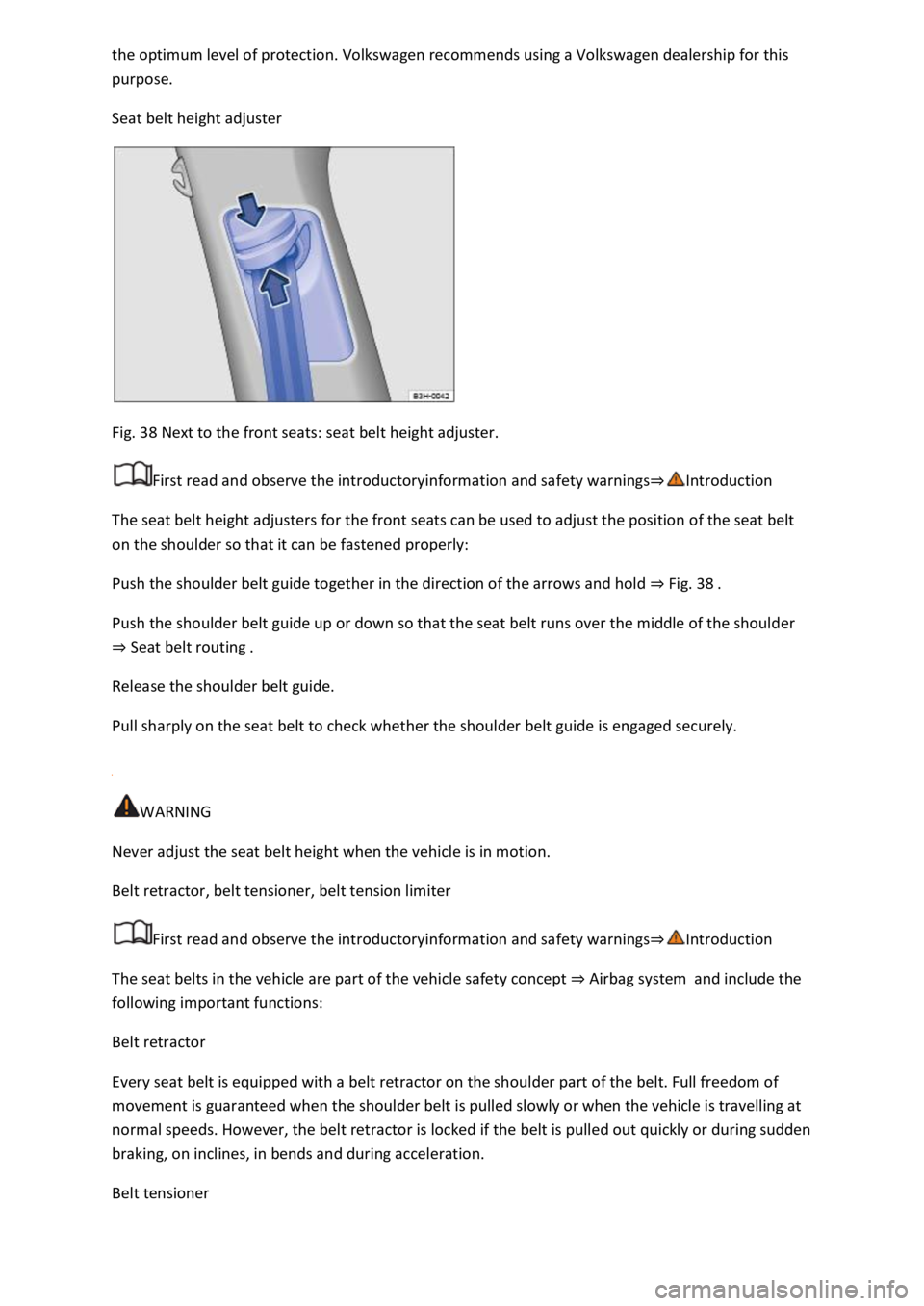
purpose.
Seat belt height adjuster
Fig. 38 Next to the front seats: seat belt height adjuster.
First read and observe the introductoryinformation and safety warnings
The seat belt height adjusters for the front seats can be used to adjust the position of the seat belt
on the shoulder so that it can be fastened properly:
Push the shoulder belt guide together in the direction of the arrows and hold Fig. 3
Push the shoulder belt guide up or down so that the seat belt runs over the middle of the shoulder
Seat belt routing
Release the shoulder belt guide.
Pull sharply on the seat belt to check whether the shoulder belt guide is engaged securely.
WARNING
Never adjust the seat belt height when the vehicle is in motion.
Belt retractor, belt tensioner, belt tension limiter
First read and observe the introductoryinformation and safety warnings
The seat belts in the vehicle are part of the vehicle safety concept Airbag systemand include the
following important functions:
Belt retractor
Every seat belt is equipped with a belt retractor on the shoulder part of the belt. Full freedom of
movement is guaranteed when the shoulder belt is pulled slowly or when the vehicle is travelling at
normal speeds. However, the belt retractor is locked if the belt is pulled out quickly or during sudden
braking, on inclines, in bends and during acceleration.
Belt tensioner
Page 76 of 502

seats when driving with children.
Note the following:
Child seats are classified into groups depending on the size, age and weight of child for which they
are designed.
Various securing systems are used to secure child seats in the vehicle.
For safety reasons, child seats must always be fitted to the rear seats Fitting and usi
Volkswagen recommends child seats from the Volkswagen range of accessories. These child seats
have been developed and approved for use in Volkswagen vehicles.
WARNING
If children are not secured or are inadequately secured, they are at greater risk of serious or even
fatal injury. Please note the following:
Children who are either under twelve years of age or less than 150 cm tall must not be carried in the
vehicle if they are not secured in a suitable child seat while the vehicle is in motion. Regulations in
some countries may differ and must be complied with.
Always secure children in the vehicle in a suitable child seat. The seat used must be appropriate to
the child's height, weight and age.
Never fasten more than one child into one child seat.
Under no circumstances should children or babies be held in a passenger's or drivers lap while
driving.
Never leave a child unsupervised in a child seat.
Never allow a child to be carried in a vehicle without being properly secured, and never allow a child
to stand up or to kneel on a seat, or to sit incorrectly while the car is in motion. This is particularly
important for children carried on the front passenger seat. In an accident, children may sustain
serious injuries to themselves and others.
The child seat can provide maximum protection only if the seat belt is routed correctly around it.
Always ensure that the seat belt is routed as specified in the instructions provided by the child seat
manufacturer. If the seat belt is routed incorrectly, injuries may occur even in a minor accident.
After an accident, it is vital to replace any child seats that were in use during the accident, as they
could have sustained non-visible damage.
Types of child seat
Page 79 of 502
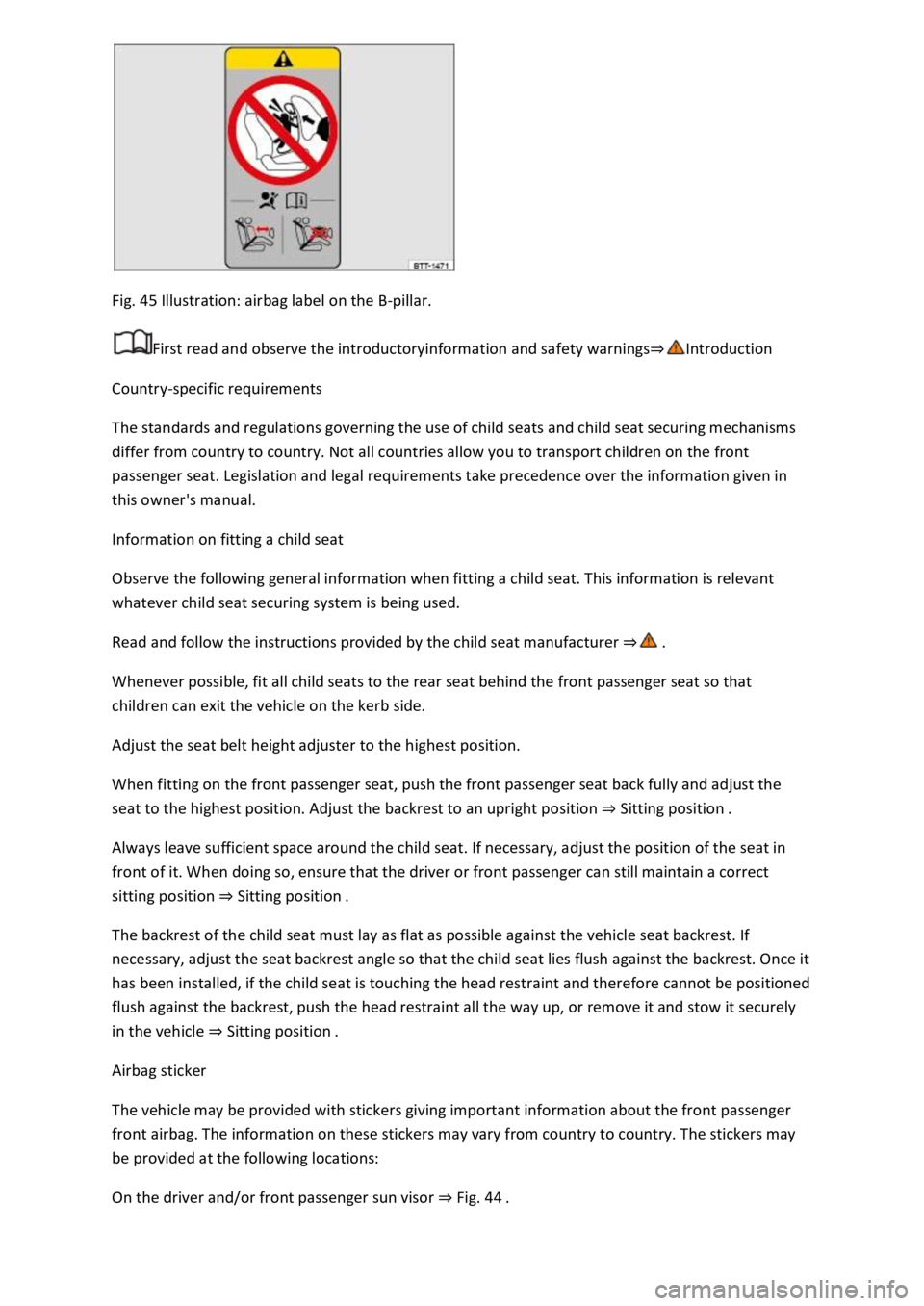
Fig. 45 Illustration: airbag label on the B-pillar.
First read and observe the introductoryinformation and safety warnings
Country-specific requirements
The standards and regulations governing the use of child seats and child seat securing mechanisms
differ from country to country. Not all countries allow you to transport children on the front
passenger seat. Legislation and legal requirements take precedence over the information given in
this owner's manual.
Information on fitting a child seat
Observe the following general information when fitting a child seat. This information is relevant
whatever child seat securing system is being used.
Read and follow the instructions provided by the child seat manufacturer
Whenever possible, fit all child seats to the rear seat behind the front passenger seat so that
children can exit the vehicle on the kerb side.
Adjust the seat belt height adjuster to the highest position.
When fitting on the front passenger seat, push the front passenger seat back fully and adjust the
seat to the highest position. Adjust the backrest to an upright position Sitting position
Always leave sufficient space around the child seat. If necessary, adjust the position of the seat in
front of it. When doing so, ensure that the driver or front passenger can still maintain a correct
sitting position Sitting position
The backrest of the child seat must lay as flat as possible against the vehicle seat backrest. If
necessary, adjust the seat backrest angle so that the child seat lies flush against the backrest. Once it
has been installed, if the child seat is touching the head restraint and therefore cannot be positioned
flush against the backrest, push the head restraint all the way up, or remove it and stow it securely
in the vehicle Sitting position
Airbag sticker
The vehicle may be provided with stickers giving important information about the front passenger
front airbag. The information on these stickers may vary from country to country. The stickers may
be provided at the following locations:
On the driver and/or front passenger sun visor Fig. 44
Page 80 of 502
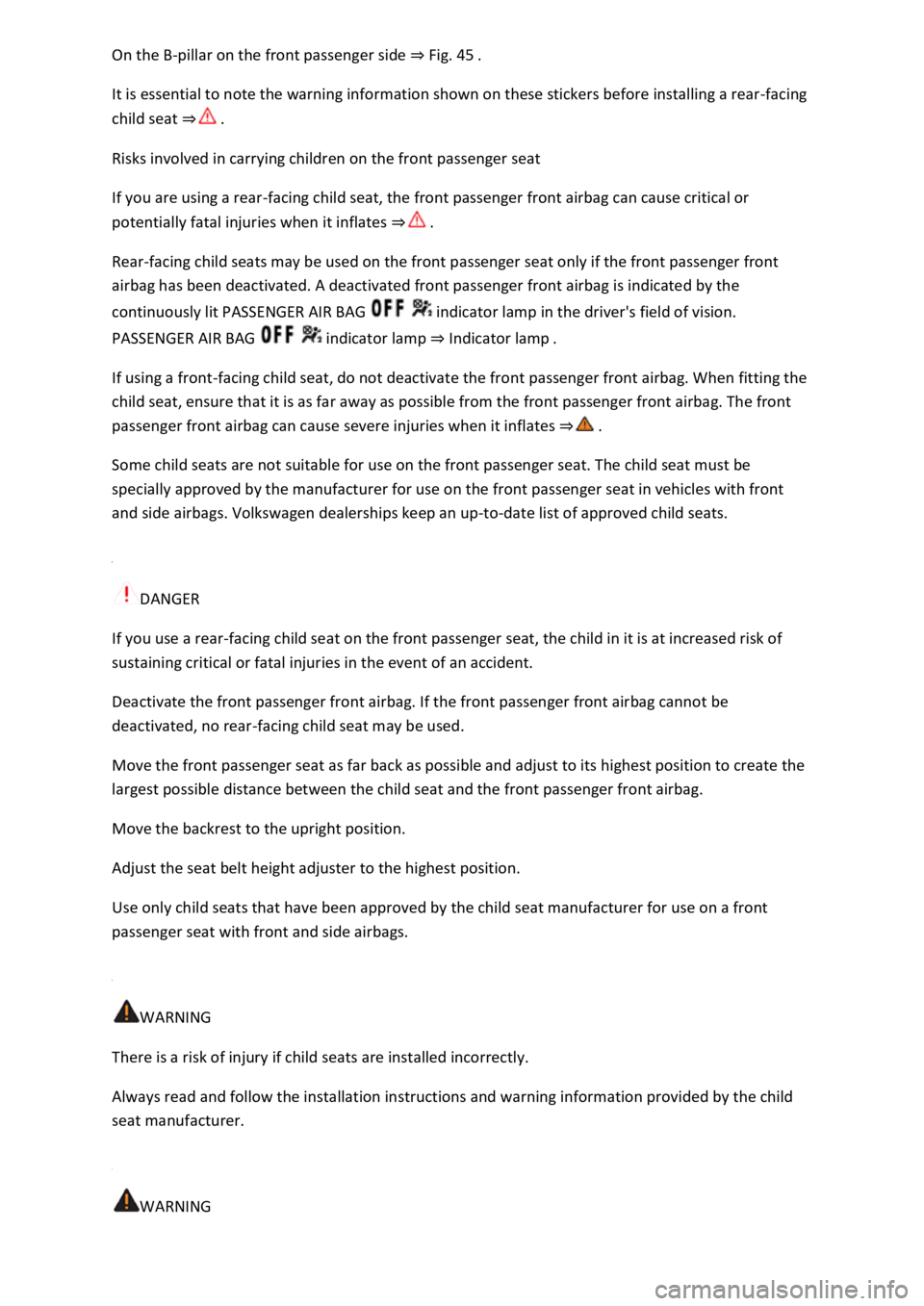
-pillar on the front passenger side Fig. 45
It is essential to note the warning information shown on these stickers before installing a rear-facing
child seat
Risks involved in carrying children on the front passenger seat
If you are using a rear-facing child seat, the front passenger front airbag can cause critical or
potentially fatal injuries when it inflates
Rear-facing child seats may be used on the front passenger seat only if the front passenger front
airbag has been deactivated. A deactivated front passenger front airbag is indicated by the
continuously lit PASSENGER AIR BAG indicator lamp in the driver's field of vision.
PASSENGER AIR BAG indicator lamp Indicator lamp
If using a front-facing child seat, do not deactivate the front passenger front airbag. When fitting the
child seat, ensure that it is as far away as possible from the front passenger front airbag. The front
passenger front airbag can cause severe injuries when it inflates
Some child seats are not suitable for use on the front passenger seat. The child seat must be
specially approved by the manufacturer for use on the front passenger seat in vehicles with front
and side airbags. Volkswagen dealerships keep an up-to-date list of approved child seats.
DANGER
If you use a rear-facing child seat on the front passenger seat, the child in it is at increased risk of
sustaining critical or fatal injuries in the event of an accident.
Deactivate the front passenger front airbag. If the front passenger front airbag cannot be
deactivated, no rear-facing child seat may be used.
Move the front passenger seat as far back as possible and adjust to its highest position to create the
largest possible distance between the child seat and the front passenger front airbag.
Move the backrest to the upright position.
Adjust the seat belt height adjuster to the highest position.
Use only child seats that have been approved by the child seat manufacturer for use on a front
passenger seat with front and side airbags.
WARNING
There is a risk of injury if child seats are installed incorrectly.
Always read and follow the installation instructions and warning information provided by the child
seat manufacturer.
WARNING